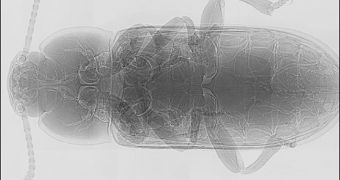It seems simple in case of insects: oxygen goes directly to the cells without the need of blood.
But powerful X-ray technology that peers through the opaque beetles' cover has revealed a much higher complexity of their breathing apparatus. A recent investigation shows that insect respiration is more than a passive flow in and out, being more like a swift inflation and deflation of tracheal tubes pushing the oxygen through their bodies. "These tubes are being compressed in rhythmic fashion, and in this species (ground beetle) it happens in the course of a second," said researcher Jake Socha of Argonne National Laboratory in Illinois. "Tracheal compression," analogous to breathing in vertebrates and humans, could be moved by a muscle pump.
Beetles have 18 tiny openings (spiracles) in the middle and hind part of their bodies through which oxygen-rich air enters into the tracheal tubes. From the tracheal tubes, the oxygen enters through thousands of interconnected and branching tubes and reaches the cells, while the opposite way is made by the carbon dioxide. But when an animal gets bigger, its volume bypasses the increase of its area and this happens also with the cells. "If you look at a single cell, as the cell gets larger diffusion (random movement of the molecules) isn't going to work to get oxygen into the cell because diffusion only goes a certain distance," said Scott Kirkton of Union College in New York, not involved in this beetle study. "As the surface area to volume ratio gets smaller, you're not going to be able to get [oxygen] in. You need to have some other way to transport it," Kirkton told LiveScience.
Recent researches revealed how insects - including beetles, dragonflies and cockroaches - use active body movements for respiration. Wings pumping or belly pulling were also found as mechanisms of respiration, all being convective (bulk movement of the air). "[Insect] breathing is much more similar to us than what people originally thought. They have a convective component like we do, and they have a diffusive component like we do," Kirkton said.
Now a technique based on high-powered X-ray beams (a billion times more powerful than those used in hospitals) allowed a view under the chitin skeleton of living, breathing beetles. The team saw "pencil outlines" of the hair-thin breathing tubes, which squeezed and released in an undulating pattern of a perfectly scheduled cycle. "So in a second you have deflation and then rapid re-inflation. It appears to be happening everywhere at once," Socha said.
An odd pattern of tiny indentations along each tube emerged, as the animal inhaled and exhaled. "These compressions appear to be these football-shaped dimples that are being pushed into the tracheal tubes," Socha said.
But their role remains unknown. "The squeeze out may speed up the flow of fresh air in, aiding oxygen exchange," Socha explained. By expelling carbon dioxide faster, the spiracles would lower water loss through the spiracles. "Or it may simply move air within the body," Socha said.

 14 DAY TRIAL //
14 DAY TRIAL //